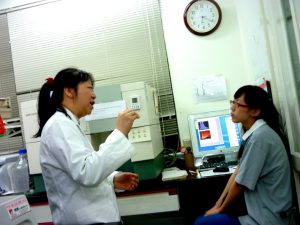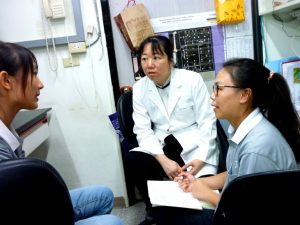Uncover the mystery of Bacillus anthracis lethal toxin-final
Uncover the mystery of Bacillus anthracis lethal toxin
Bacillus anthracis spores are deadly biological weapons. After terrorists delivered mails containing anthrax spores in 2001 in the United States, again awaken the world to the attention of anthrax. Dr. Der-Shan Sun, Professor at the Department of Molecular Biology and Human Genetics of Tzu Chi University cooperated with Professor Hsin-Hou Chang and Institute of Preventive Medicine and Department of Obstetrics and Gynecology of Mennonite Christian Hospital. They found that anthrax lethal toxin can kill megakaryocytes (the precursor cells of platelets in the bone marrow) and red blood precursor cells, and cause anthrax symptoms like thrombocytopenia, anemia, hypoxia in mice model; however, if administered thrombopoietin (TPO), erythropoietin (EPO) or granulocyte colony-stimulating factor (G-CSF) to promote platelet production, erythropoiesis and released into the peripheral blood, you can relieve these symptoms, and improve the survival in anthrax lethal toxin-injected mice. These results provide another way to treat anthrax besides antibiotic use. These findings were published in three recent papers (PLoS ONE, 8, e59512, 2013; PLoS ONE, 8, e71718, 2013; PLoS ONE, 9, e111149, 2014) [1-3].
Anthrax is a zoonotic disease, usually only infect person engaged in agriculture or eating anthrax infected-meat. Bacillus anthracis spores can survive under heat or cold environment for many years. Early flu-like symptoms of anthrax is not easy to attract attention. If found early, antibiotics can be used to effetely kill anthrax, but once the treatment is not immediately lead to the release of anthrax toxins over the body, nothing will be helpful. Thus, the development of additional therapy against anthrax toxin is a very important issue.
These fruitful results are from the cooperation with the Institute of Preventive Medicine and Department of Obstetrics and Gynecology of Mennonite Christian Hospital and the Medical Statistics Jen-Hung Wang from Buddhist Tzu Chi General Hospital. In addition, hard works and research efforts from master students of Department of Molecular Biology and Human Genetics and doctoral students from Institute of Medical Sciences in Professor Der-Shan Sun’s and Professor Hsin-Hou Chang’s laboratories are the major contribution. All results come from the excellent research environment from the animal center and the center of Campus Precious Instrument of Tzu-Chi University as well as financial support from Tzu-Chi University, Ministry of Education, and Ministry of Science and Technology. The research teams currently use Bacillus anthracis lethal toxin as molecular screening tool for further study the molecular mechanism of erythropoiesis and megakaryopoiesis.
Related Links
Professor Der-Shan Sun laboratory site: http://dssun.tcu.edu.tw/
[1] H.H. Chang, T.P. Wang, P.K. Chen, Y.Y. Lin, C.H. Liao, T.K. Lin, Y.W. Chiang, W.B. Lin, C.Y. Chiang, J.H. Kau, H.H. Huang, H.L. Hsu, C.Y. Liao, D.S. Sun, Erythropoiesis suppression is associated with anthrax lethal toxin-mediated pathogenic progression, PLoS One 8 (2013) e71718.
http://www.ncbi.nlm.nih.gov/pmc/articles/PMC3747219/pdf/pone.0071718.pdf
[2] P.K. Chen, H.H. Chang, G.L. Lin, T.P. Wang, Y.L. Lai, T.K. Lin, M.C. Hsieh, J.H. Kau, H.H. Huang, H.L. Hsu, C.Y. Liao, D.S. Sun, Suppressive effects of anthrax lethal toxin on megakaryopoiesis, PLoS One 8 (2013) e59512. http://www.ncbi.nlm.nih.gov/pmc/articles/PMC3605335/pdf/pone.0059512.pdf
[3] H.H. Chang, Y.W. Chiang, T.K. Lin, G.L. Lin, Y.Y. Lin, J.H. Kau, H.H. Huang, H.L. Hsu, J.H. Wang, D.S. Sun, Erythrocytic mobilization enhanced by the granulocyte colony-stimulating factor is associated with reduced anthrax-lethal-toxin-induced mortality in mice, PLoS One 9 (2014) e111149. http://www.ncbi.nlm.nih.gov/pmc/articles/PMC4226491/pdf/pone.0111149.pdf
Professor Der-Shan Sun laboratory currently has a doctoral program, four master classes (including three of five consistent students and an exchange student) and 10 undergraduate students. Weekly meetings are held to discuss the progress and experiments of each student.
Professor Der-Shan Sun discussed the procedure of cord blood stem cells culture with students.
Professor Der-Shan Sun discussed the flow cytometry data with student.
Professor Der-Shan Sun discussed the experimental processes with students




